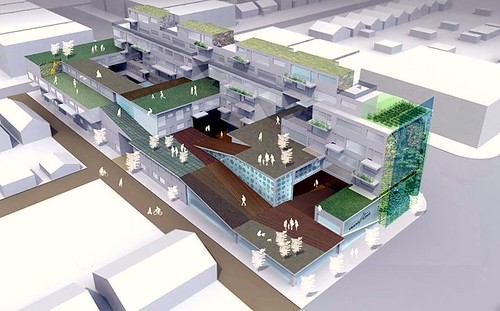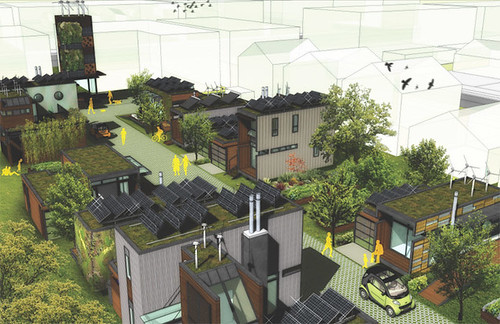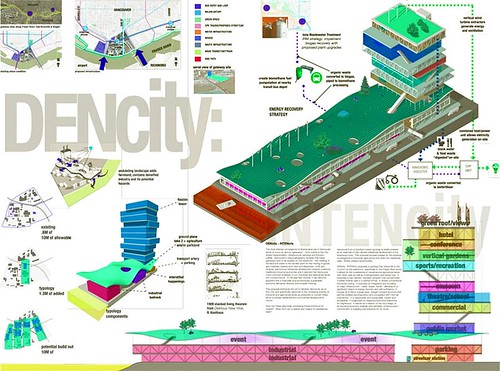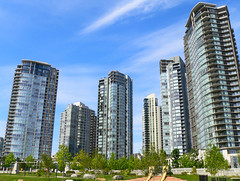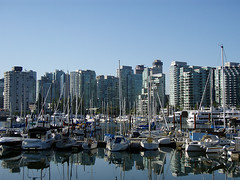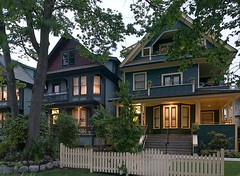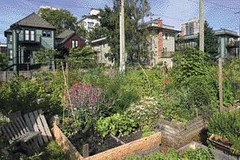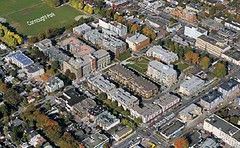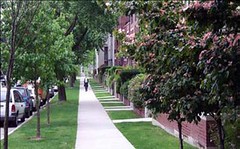Vancouver gets creative with density

Posted August 28, 2009 at 1:30PM
If the Reburbia contest sponsored by Dwell and Inhabitat was all about flights of imagination to reconceive suburbs, then FormShift Vancouver, a competition sponsored by the Architectural Institute of British Columbia and the City of Vancouver, was all about flights of imagination in reconceiving cities. But, unlike the ruralist dreams of some who are wanting to remake (some) cities, FormShift was specifically about how to do so within a context of urban density, and in the North American city that has been the most deliberate about increasing density to reduce its per-capita environmental footprint.
The winners and honorable mentions were announced in April and summarized on the Bustler website. Pictured at the top of this post is the winner in the "primary" category, which solicited a design for a mixed-use site that might be placed along a major Vancouver street with a rapid transit station. It was submitted by Sturgess Architecture and is all about making productive use of the building's surfaces: for harvesting rainwater, for growing things, for providing public space for recreation and relaxation. The Bustler article quotes the architects as saying, "All buildings located on primary sites should offer the city more than just density." Now there's an idea.
The charge to competitors in the secondary category was to design for a smaller site that might be found in an established Vancouver residential neighborhood. The winner, pictured just above, was submitted by Romses Architects and is called Harvest Green. It builds on the concept of laneway housing, or garage apartments and coach houses that face alleys. It's a great way to add some density and housing variety to a traditional residential neighborhood without disturbing the basic character of the neighborhood.
The Romses entry contemplates using prefab construction and makes the most of the opportunity to incorporate green features such as solar panels, vegetated roofs, and even a partially vegetated laneway (or alley). There's a lot more about the Harvest Green concept on the designbloom website. (Incidentally, Vancouver's city council recently approved ordinances to make laneway housing, along with in-home suites, easier to build.)
The charge to the third or "wild card" category was simply to "push the envelope of sustainable design and community building for Vancouver. This may be an aggressively imaginative, speculative and/or futuristic concept that suggests a radically new model." The winning design, above, by the Go Design Collaborative, employs stacked surfaces in a waterfront development to provide multiple commercial, industrial, agricultural, hotel, sports, and other functions that can evolve and change over time. (The one thing that Go Design seems to want to preclude is residential development, perhaps in reaction to the many condo towers that have recently been built on Vancouver's waterfront.)
Lots more information about these and the other entries may be found on the Bustler and FormShift sites.
While I am not totally sold on the way that Vancouver has been developing recently - there is a uniformity to the new tower architecture that doesn't appeal to me or, apparently, to some of the city's residents - I am seriously impressed that the city is trying to address the negatives that can be associated with density and to seek help and creativity in meeting the challenges. There are innovative planning staffs now in many large US cities, including my own, and I really hope they take note, especially in getting greener, more imaginative, and in some cases gentler, design around major transit stations. I would love to see more design competitions like this. We can't continue to accept the status quo.
The principal champion of Vancouver's "EcoDensity" initiative, chief city planner Brent Toderian, would seem to agree. Although the city's new development is best known for its highly visible (literally) towers, Toderian stressed to Adam Gaumont of Granville Online that high-rises aren't the only way to go:
"'Talking about density in cities is not easy,' [Toderian] says. 'But as long as it's done right, density doesn't have to be controversial.
"'When folks suggested height or were concerned about height,' Toderian says of the community meetings he's attended, 'I often pointed out to them that the initiative was not called EcoHeight... And often individuals are more sensitive to height than they are to density.'"
Gaumont continues:
"In fact, none of the EcoDensity Priority Action Items the city introduced in June involve condo development or rezoning, two of the thorniest density-related issues. Instead, the city is focusing on various types of secondary suites, coining terms such as 'gentle density' (row houses), 'hidden density' (laneway housing) and 'invisible density' (suites within suites) to refer to housing that's designed to blend in with existing neighborhoods."
Beyond accessory units, I came across some very interesting examples of good moderate density in Vancouver while researching this article. In the unfortunately named Mole Hill neighborhood, for example, historic houses owned by the city (photos above) have been converted into beautiful multi-unit, affordable homes, served by a community garden. Helena Grdadolnik writes in Canadian Architect:
"In Vancouver, heritage preservation is often no more than a façade . . . At Mole Hill this was not the case, as the forms were not the only aspect of the heritage buildings kept intact; the present function of the housing is also historically consistent with its original use. Most of the 28 homes in the redevelopment had been built as boarding houses for labourers who came to Vancouver in search of work in the late 19th and early 20th century. Fast forward 100 years later and the Mole Hill Housing Co-operative provides 168 rental units for low- to medium-income residents.
"The Mole Hill redevelopment is exemplary because it combines heritage conservation, social housing, urban planning and the latest in sustainable development . . . The urban fabric of a century before has also been kept with fully intact Victorian streetscapes that reveal the variety of architectural features from the age."
Mole Hill received the 2007 project award from Smart Growth BC.
Another example, Artubus Walk is a beautiful area of separately-designed, low- and mid-rise condo buildings in West Vancouver, on the former site of the Carling Brewery. I have to say that it looks exactly like the kind of neighborhood that I hope LEED-ND will catalyze. It functions well, too, with 10 percent below-market housing, ample green space, and a lower rate of automobile use than some of the city's high-rise neighborhoods. (Check out the other images and description of Artubus Walk in this very interesting document developed by the University of British Columbia Design Centre for Sustainability, for the District of North Vancouver.) I don't see much new development where I live built to this appealing scale, and I wish I did.
